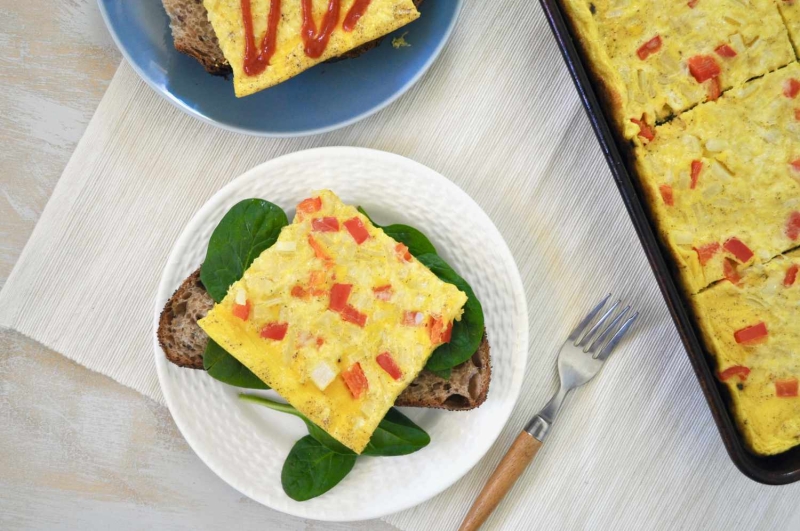Easy breakfast prep for on-the-go or feeding a crowd
Prep: 10 mins
Cook: 15 mins
Total: 25 mins
Servings: 12 servings
Yield: 1 sheet pan
Mornings can be a busy time, and breakfast is often the most neglected meal of the day. The easiest, quickest dish that requires minimal planning often wins, especially if you’re feeding a crowd. If you’re sick of granola bars and want to add a warm meal to your morning routine, give sheet pan eggs a try.
Sheet pan eggs are a quick and easy way to cook a lot of eggs at once. The results are similar to a frittata or a thick omelet, making them especially good for piling on bagels or toast. There are a few big pluses to baking eggs in the oven: there’s minimal prep, you don’t have to stand around to watch them cook, they can feed a crowd, take care of your meal prep for the week, and they’re versatile.
Enjoy sheet pan eggs as-is for a high-protein breakfast, maybe with a dash or two of hot sauce. Use them as the protein on your breakfast sammie (it’s the perfect size for square bread) or combine them with cooked potatoes and salsa for breakfast burritos. This recipe recommends adding shredded cheese and diced peppers and onions for flavor and texture, but feel free to leave them out or add your favorite mix-ins.
Ingredients
-
Cooking spray or vegetable oil/butter to grease pan
-
18 large eggs
-
1/2 cup milk , or non-dairy alternative
-
1 1/4 teaspoons kosher salt
-
1/2 teaspoon ground black pepper
-
1 cup shredded cheddar cheese , or shredded cheese of your choice
-
1/2 cup bell pepper, diced small
-
1/4 cup onion, diced small
Steps to Make It
-
Gather the ingredients.
-
Preheat the oven to 375 F. Use cooking spray to generously grease a rimmed half sheet pan, approximately 18-x 13-inches.
In a large mixing bowl, combine the eggs, milk, salt, and pepper. Beat with a whisk until all of the eggs are broken up and the mixture is a uniform yellow color.
-
Carefully pour the egg mixture into the prepared sheet pan. If using, sprinkle the cheese over top followed by the peppers and onions.
-
Bake just until the eggs are cooked through in the center, about 15 minutes.
-
Let cool for a few minutes in the pan. Use a sharp knife to cut into 12 squares. Enjoy!
How to Store and Freeze
- Slice and store leftover sheet pan eggs in an airtight container in the fridge, separating layers using parchment or waxed paper. The eggs will keep for three days and can be reheated in a toaster oven or microwave.
- To freeze, layer the slices of eggs with plastic wrap and wrap tightly. Add to a zip-top freezer bag, squeeze out the air, and freeze for up to three months. Defrost in the fridge before reheating and using.
Recipe Tip
If you're worried about spilling the egg mixture while transferring it to the oven, you can do things in a slightly different order.
- After mixing up the eggs, pull the oven rack out and add the prepared sheet pan.
- Pour the egg mixture into the pan (already in the oven), taking care not to burn yourself.
- Add any toppings, slide the rack inside, and bake.
Recipe Variations
It’s easy to customize sheet pan eggs to suit your tastes. You can even add different toppings to each half of the pan. Watery ingredients (like frozen spinach) should be cooked or squeezed dry before using. In addition to shredded cheese, peppers, and onions, try some of these tasty options and mix and match as you please:
- Up to 1/2 cup diced ham or cooked, drained sausage or bacon
- 1/2 cup frozen spinach, thawed, drained, and squeezed of excess liquid
- Up to 1/2 cup sautéed mushrooms, any liquid drained away
- Swap the shredded cheese for 1/2 cup crumbled feta or goat cheese
- 1/4 cup chopped sun-dried tomatoes
- 1/4 cup sliced black olives
| Nutrition Facts | |
|---|---|
| Servings: 12 | |
| Amount per serving | |
| Calories | 113 |
| % Daily Value* | |
| Total Fat 7g | 9% |
| Saturated Fat 2g | 12% |
| Cholesterol 280mg | 93% |
| Sodium 242mg | 11% |
| Total Carbohydrate 1g | 0% |
| Dietary Fiber 0g | 0% |
| Total Sugars 1g | |
| Protein 10g | |
| Vitamin C 0mg | 0% |
| Calcium 55mg | 4% |
| Iron 1mg | 7% |
| Potassium 121mg | 3% |
| *The % Daily Value (DV) tells you how much a nutrient in a food serving contributes to a daily diet. 2,000 calories a day is used for general nutrition advice. | |


